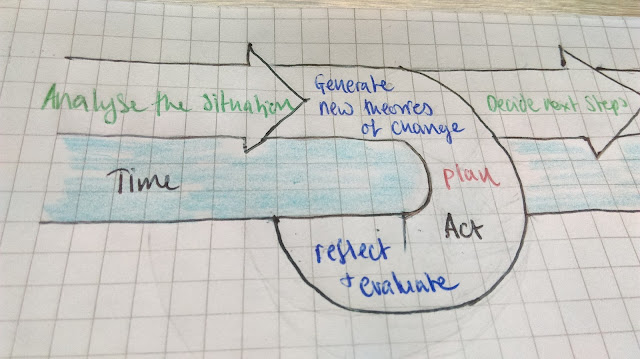On The Big Screen
After trying my games with all my students individually during the week, today was the time to play on the big screen in a group setting. I chose the note naming game as it was the more popular of the two. I made one simple change to the game as a result of feedback I got during the week, shortening the gaps between the questions and so making it possible to achieve a much higher score in the same time-frame.
It was interesting to watch the group dynamics as they each took a turn at playing the game. They decided they would play in order of youngest to oldest and it was great to see the older ones encouraging the youngest little girl and sometimes giving her hints when she wasn't sure which note to pick. They all watched each other intently, commenting on what their tactics would be as a result of what they had seen. The competitive spirit was running high but thankfully not high enough to cause arguments or tears!
Serena Croft comments that Ciskszentmihayl’s concept of ‘flow’
provides theoretical backing to what many people claim to be the motivating
qualities of music technology and I think it also shows why gamification can be
a great motivational tool in education.[1],[2]
Flow happens when your body or mind is stretched to its limits as you try to achieve
something difficult or worthwhile for its own sake – because you want to.[3]
Ciskszentmihayl outlines 9 dimensions, at least some of which need to be
present for flow to occur whilst being engaged in a task.[4]
Watching my students playing the game today I was able to identify several of
these dimensions:
·
Clear goals every step of the way – they knew the rules of the game.
·
Immediate feedback for your actions – green tick and applause for a right answer and
a buzzer and red cross if it was wrong.
·
Balance between challenge and skills – the game was just hard enough to challenge
them but not so hard that it was beyond their level of skill.
·
Sense of time-elapsed becomes distorted – they were surprised that the time was
already up when they got to the end of the game.
·
Distractions excluded from consciousness – this wasn’t the case for all of them, but most
of them were so engrossed in playing the game they had no reaction to the
comments and remarks made by the others who were watching them.
Some of the other dimensions though were not present:
- · No fear of failure – several of them commented whilst they were playing about how bad they were at the game and how they were afraid they would get a low score.
- · Self-consciousness disappears – some of them were obviously nervous as they sat down to take their turn at the game because they were conscious that we were all watching and that we would all know if they beat the high score or not.
Talking with them all afterwards the general feeling was
that it had been a lot of fun. They liked the way the questions came around faster
and they all said they think it has helped them consolidate their knowledge of
the D major scale! Perhaps they said that because they think that is what I
want to hear, but today only one of them made any mistakes in identifying the
notes. During the week when they tried the game only one person made no
mistakes, so I think it is fair to say that they have either improved their note
reading skills or their game playing skills this week!
Brown, Andrew R. Music Technology and Education [Electronic
Resource]: Amplifying Musicality. Second edition. New York, New York:
Routledge, 2015.
“Gamification in Education- What, How,
Why Bother - Lee-Hammer-AEQ-2011.pdf | Game Design | Self-Improvement.” Scribd.
Accessed April 15, 2017.
https://www.scribd.com/document/139416313/Gamification-in-Education-What-How-Why-Bother-Lee-Hammer-AEQ-2011-pdf.
Music Education
with Digital Technology [Electronic Resource]. London:
Continuum, 2007.
[1] Music Education with Digital Technology
[Electronic Resource], 41.
[2] “Gamification in Education- What, How,
Why Bother - Lee-Hammer-AEQ-2011.pdf | Game Design | Self-Improvement,” 1.
[3] Brown, Music Technology and Education
[Electronic Resource], 23.
[4] Music Education with Digital Technology
[Electronic Resource], 42.



Comments
Post a Comment